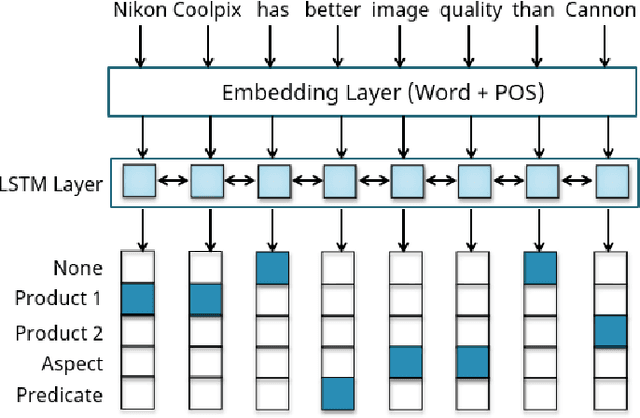Sayan Pathak
Extracting Entities of Interest from Comparative Product Reviews
Oct 31, 2023



Abstract:This paper presents a deep learning based approach to extract product comparison information out of user reviews on various e-commerce websites. Any comparative product review has three major entities of information: the names of the products being compared, the user opinion (predicate) and the feature or aspect under comparison. All these informing entities are dependent on each other and bound by the rules of the language, in the review. We observe that their inter-dependencies can be captured well using LSTMs. We evaluate our system on existing manually labeled datasets and observe out-performance over the existing Semantic Role Labeling (SRL) framework popular for this task.
* Source Code: https://github.com/jatinarora2702/Review-Information-Extraction
Smart Speech Segmentation using Acousto-Linguistic Features with look-ahead
Oct 27, 2022



Abstract:Segmentation for continuous Automatic Speech Recognition (ASR) has traditionally used silence timeouts or voice activity detectors (VADs), which are both limited to acoustic features. This segmentation is often overly aggressive, given that people naturally pause to think as they speak. Consequently, segmentation happens mid-sentence, hindering both punctuation and downstream tasks like machine translation for which high-quality segmentation is critical. Model-based segmentation methods that leverage acoustic features are powerful, but without an understanding of the language itself, these approaches are limited. We present a hybrid approach that leverages both acoustic and language information to improve segmentation. Furthermore, we show that including one word as a look-ahead boosts segmentation quality. On average, our models improve segmentation-F0.5 score by 9.8% over baseline. We show that this approach works for multiple languages. For the downstream task of machine translation, it improves the translation BLEU score by an average of 1.05 points.
TRScore: A Novel GPT-based Readability Scorer for ASR Segmentation and Punctuation model evaluation and selection
Oct 27, 2022Abstract:Punctuation and Segmentation are key to readability in Automatic Speech Recognition (ASR), often evaluated using F1 scores that require high-quality human transcripts and do not reflect readability well. Human evaluation is expensive, time-consuming, and suffers from large inter-observer variability, especially in conversational speech devoid of strict grammatical structures. Large pre-trained models capture a notion of grammatical structure. We present TRScore, a novel readability measure using the GPT model to evaluate different segmentation and punctuation systems. We validate our approach with human experts. Additionally, our approach enables quantitative assessment of text post-processing techniques such as capitalization, inverse text normalization (ITN), and disfluency on overall readability, which traditional word error rate (WER) and slot error rate (SER) metrics fail to capture. TRScore is strongly correlated to traditional F1 and human readability scores, with Pearson's correlation coefficients of 0.67 and 0.98, respectively. It also eliminates the need for human transcriptions for model selection.
 Add to Chrome
Add to Chrome Add to Firefox
Add to Firefox Add to Edge
Add to Edge